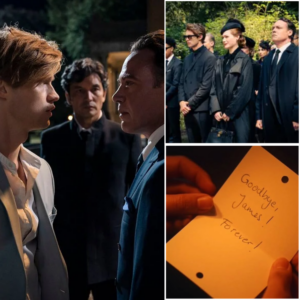Before Henry Cavill became a household name as Superman in Man of Steel or Geralt of Rivia in The Witcher, he was a young actor cutting his teeth in Hollywood with smaller roles that showcased his potential. Among these early gigs is a lesser-known entry in the Hellraiser franchise: Hellraiser: Hellworld (2005). This eighth installment in Clive Barker’s iconic horror series is often overlooked by fans and critics alike, but it holds a unique place in Cavill’s career as one of his first film roles. Starring a then-22-year-old Cavill alongside horror legend Doug Bradley as Pinhead and genre veteran Lance Henriksen, Hellraiser: Hellworld is a fascinating, if flawed, artifact of Cavill’s rise to stardom. This article dives into Cavill’s role in the film, its place in the Hellraiser franchise, why it’s a curious footnote in his filmography, and how it reflects the early stages of his journey to A-list status.
The Hellraiser Legacy: From Horror Classic to Direct-to-Video Sequels
To understand Hellraiser: Hellworld, it’s essential to contextualize it within the Hellraiser franchise. The original Hellraiser (1987), written and directed by Clive Barker and based on his novella The Hellbound Heart, is a horror masterpiece. Introducing the Cenobites—sadomasochistic beings led by the iconic Pinhead (Doug Bradley)—the film blended visceral gore, psychological terror, and a unique exploration of pleasure and pain. Its success spawned a franchise, but by the time Hellraiser: Hellworld arrived in 2005, the series had shifted from theatrical releases to direct-to-video sequels, with diminishing returns in quality and critical reception.
Hellraiser: Hellworld, directed by Rick Bota, was the eighth film in the series and marked Bradley’s final appearance as Pinhead. Unlike the earlier films, which focused on the Lament Configuration puzzle box and the Cenobites’ otherworldly horrors, Hellraiser: Hellworld took a meta approach. The story revolves around a group of young gamers obsessed with an online MMORPG called “Hellworld,” inspired by the Hellraiser mythos. After the suicide of their friend Adam, who was consumed by the game, the group receives invitations to a secretive Hellworld-themed party at a creepy mansion, hosted by the enigmatic Host (Lance Henriksen). What unfolds is a mix of slasher tropes, psychological horror, and a late-game twist that reveals the party is a drug-induced hallucination orchestrated by the Host, who seeks revenge for his son’s death. The Cenobites, including Pinhead, appear sparingly, making the film feel disconnected from the franchise’s roots.
The movie’s premise, while intriguing for its early-2000s fascination with internet culture (taglined “Evil Goes Online”), was poorly executed. Critics panned it, with Rotten Tomatoes assigning a 0% Tomatometer score from six reviews and a 22% audience score. Reviewers called it “weak,” “moronic,” and “barely a Hellraiser movie,” citing its clichéd dialogue, lack of suspense, and forced integration of Hellraiser elements. Despite its flaws, the film remains notable for featuring a young Henry Cavill in one of his earliest roles, offering a glimpse of the charisma and intensity that would later define his career.
Henry Cavill’s Role as Mike: A Sleazy Stepping Stone
In Hellraiser: Hellworld, Cavill plays Mike, a sex-obsessed member of the gamer group who attends the ill-fated Hellworld party. Described as a “sleazy frat boy” by some reviewers, Mike is a far cry from the stoic heroes Cavill would later portray. His character is brash, flirtatious, and reckless, eagerly indulging in the party’s debauchery. Cavill’s performance, while not the film’s centerpiece, is compelling for its raw energy. At just 22, he displays a natural screen presence, even if the script gives him little to work with. Posts on X from fans, such as @cineskin in 2020, have noted the humor in seeing a young Cavill in such an unpolished role, calling it a “before they were famous” gem.
Mike’s arc in the film is brief and brutal. Lured to a remote part of the mansion by a mysterious woman, he meets a gruesome end when a giant hook impales him through the chest, swings him around a room, and leaves him to bleed out. In a nod to the Hellraiser aesthetic, Mike later reappears as a Cenobite, his face stitched and chest bloodied, a transformation that Cavill sells with eerie conviction. While Mike doesn’t face Pinhead directly—a missed opportunity for a retroactive “Superman vs. Pinhead” showdown—his death scene is one of the film’s gorier moments, showcasing Cavill’s willingness to embrace the horror genre’s excesses.
Cavill’s role in Hellraiser: Hellworld was a small but significant step in his early career. In 2005, he was still a relatively unknown British actor, having appeared in minor roles in films like The Count of Monte Cristo (2002) and TV shows like Midsomer Murders. Hellraiser: Hellworld offered him a chance to work alongside established actors like Henriksen and Bradley, as well as future stars like Katheryn Winnick (Vikings). Filmed in Romania between October and December 2002 alongside Hellraiser: Deader to save costs, the production was a low-budget affair, but Cavill’s involvement hints at his ambition to break into Hollywood.
Why Hellraiser: Hellworld Matters in Cavill’s Career
Hellraiser: Hellworld is not a film Cavill highlights in interviews, and it’s easy to see why. Its critical panning and status as a low-point in the Hellraiser franchise make it an unlikely candidate for pride of place in his filmography. Yet, for fans and cinephiles, the movie holds a peculiar charm. It captures Cavill at a formative stage, before he became the chiseled leading man of Man of Steel (2013) or The Witcher (2019). His lanky frame and youthful demeanor contrast sharply with the muscular, commanding presence he’d later cultivate, offering a rare look at his raw talent. As Collider noted, “the signs of superstardom were written all over” his performance, despite the film’s shortcomings.
The film also reflects Cavill’s early versatility. Playing a sleazy, ill-fated character in a horror movie required a different skill set than the heroic roles he’d later embody. His ability to convey Mike’s cocky bravado and eventual terror demonstrates an early knack for range, even within a poorly received project. Cavill’s discomfort with the film’s gratuitous sex scenes, as he later expressed on the Happy Sad Confused podcast, adds another layer of intrigue. He admitted to finding such scenes unnecessary, preferring storytelling that relies on imagination rather than “gyrating bodies.” This perspective underscores his commitment to character-driven performances, a trait that would define his later work.
For Hellraiser fans, Cavill’s presence is a curious footnote in a franchise that struggled to maintain its original vision. The film’s meta premise—blending an online game with Hellraiser lore—had potential but was hamstrung by a weak script and a twist that rendered much of the horror a hallucination. Doug Bradley’s underutilization as Pinhead, reduced to a few one-liners and a brief finale, further alienated fans, as did the minimal role of the Cenobites. Yet, Cavill’s involvement, alongside Henriksen’s menacing Host, adds a layer of intrigue for those revisiting the film. It’s a snapshot of a horror icon (Bradley) nearing the end of his tenure and a future megastar (Cavill) at the start of his ascent.
Critical Reception and Lasting Legacy
Hellraiser: Hellworld was a commercial and critical flop, released straight to DVD in the U.S. on September 6, 2005, after limited festival screenings. Critics lambasted its lack of coherence, with one Rotten Tomatoes reviewer, David Nusair, calling it “moronic” and others noting its reliance on clichés, such as characters wandering alone into dangerous rooms. The film’s 0% Tomatometer score and 22% audience rating reflect its poor reception, with many fans arguing it barely qualifies as a Hellraiser movie. Its origins as an adapted script, based on Joel Soisson’s short story Dark Can’t Breathe and retooled to fit the Hellraiser universe, explain its disjointed feel.
Despite its failures, the film has found a niche audience among Cavill fans and lovers of “so-bad-it’s-good” horror. Posts on X, such as @EmperorChris88’s in 2025, highlight its appeal as a guilty pleasure, praising Cavill’s early role and Winnick’s presence. Some viewers enjoy its campy, mid-2000s vibe, with one Rotten Tomatoes user suggesting it’s “funny” as a horror comedy with a drinking game. For Cavill completists, it’s a must-watch, offering a glimpse of the actor before his A-list status.
Cavill’s Journey Beyond Hellraiser
Hellraiser: Hellworld was a minor blip in Cavill’s career, but it didn’t slow his trajectory. In the years following, he landed roles in Stardust (2007), The Tudors (2007–2010), and Immortals (2011), steadily building his profile. His breakout as Superman in Man of Steel cemented his status as a leading man, followed by high-profile roles in Mission: Impossible – Fallout (2018), The Witcher, and Enola Holmes (2020). Today, Cavill is a global star, with upcoming projects like Amazon’s Warhammer 40,000 series and a Highlander reboot showcasing his continued ambition.
The film’s availability on streaming platforms like Prime Video (as of December 2024) and Paramount+ has kept it accessible for curious fans. For those eager to see Cavill’s early work, Hellraiser: Hellworld is a quirky detour, best approached with low expectations and an appreciation for its place in his journey. As ScreenRant noted, “Cavill does give one of the more engaging turns as the sleazy friend who meets a gory end,” making it a worthwhile watch for die-hard fans.
Conclusion: A Forgotten Gem in Cavill’s Filmography
Hellraiser: Hellworld may not be a horror classic, but its significance lies in its role as a stepping stone for Henry Cavill. As Mike, Cavill delivers a performance that, while constrained by a weak script, hints at the charisma and intensity that would propel him to stardom. The film’s place in the Hellraiser franchise is less illustrious, marking a low point in a series that struggled to recapture its original magic. Yet, for fans of Cavill or devotees of obscure horror, it’s a fascinating relic—a collision of a fading horror icon (Pinhead) and a rising star (Cavill) in a flawed but oddly compelling package. Whether you watch for Cavill’s early charm or the nostalgic thrill of mid-2000s horror, Hellraiser: Hellworld remains a curious chapter in a career that continues to soar.




